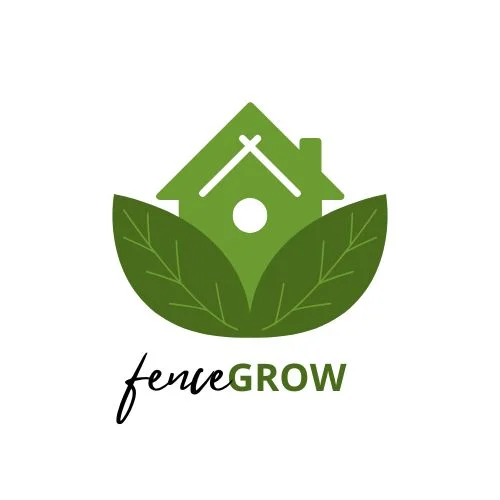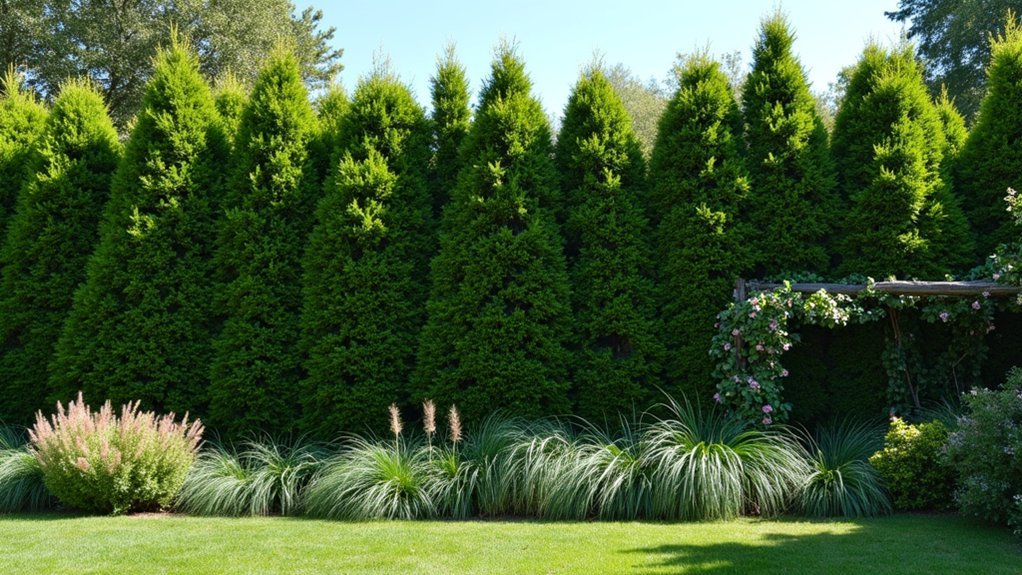For wildlife-friendly privacy fencing, you’ll get excellent results with berry-producing plants like nannyberry and winterberry, which attract birds while creating dense screening. Combine evergreens like arborvitae with deciduous options such as hybrid willows for layered coverage. Native choices like silky dogwood establish natural boundaries while supporting local ecosystems. Plant in staggered, zigzag patterns to eliminate gaps and create habitat corridors. The right combination offers both seclusion and a thriving backyard ecosystem.
Best Evergreen Shrubs for Year-Round Privacy Screens

Creating a living fence with evergreen shrubs offers the perfect solution for homeowners seeking privacy without sacrificing beauty or ecological value.
Emerald Green Arborvitae provides dense screening up to 15 feet tall, while versatile Boxwood varieties can be shaped to your preferences.
For faster results, choose Nellie Stevens Hollies, which rapidly establish impressive privacy barriers while attracting birds with their berries.
Schipka Cherry Laurel balances privacy with pollinator-friendly spring blooms. If you’ve got limited space, consider Viburnum ‘Popcorn’ with its compact structure.
Most of these options require minimal maintenance. Boxwoods and Arborvitae need occasional trimming to maintain density, while Viburnums generally demand less attention than traditional hedges.
For wildlife enthusiasts, Oak Leaf Red Holly’s distinctive leaves and red berries create habitat while ensuring year-round seclusion.
Consider planting extra shrubs elsewhere on your property as replacements if any hedge plants fail to thrive.
Fast-Growing Deciduous Trees for Natural Barriers
While deciduous trees like Hybrid Poplar and Lombardy Poplar grow impressively fast (4-8 feet annually), they’ll lose their screening ability during winter months.
You’ll achieve better year-round coverage by implementing layered planting strategies that combine these fast growers with evergreen understory shrubs.
Remember that growth rates matter when planning your natural barrier, as species like Dawn Redwood establish more slowly but provide substantial wildlife habitat once mature. The fragrant white flowers of Black Locust trees in spring can add sensory appeal while attracting beneficial pollinators to your wildlife-friendly fence.
Growth Rates Matter
When planning a natural wildlife-friendly fence, growth rates of deciduous trees matter greatly for those seeking quick privacy solutions.
You’ll find significant variability among species, with Royal Poinciana, Crepe Myrtle, and Yellow Oleander offering particularly rapid development in the right conditions.
Your local climate zone heavily influences how quickly trees establish themselves. For ideal growth, make sure your chosen species receive full sunlight and are planted in well-drained soil with appropriate pH levels. The remarkable Hybrid Willow demonstrates extreme growth rates of 6-10 feet annually, creating privacy screens within just 5 years.
Regular pruning and proper pest management will further enhance their development.
While fast-growing deciduous trees create beautiful seasonal barriers that support wildlife, remember they’ll lose leaves periodically—a consideration for year-round privacy needs.
The tradeoff, however, is their aesthetic appeal, space flexibility, and relatively low maintenance compared to evergreen alternatives.
Layered Planting Strategies
Effective wildlife-friendly fences benefit greatly from layered planting strategies that combine multiple growth heights and species. By incorporating understory planting with shrubs and herbs beneath taller trees like Red Oaks or American Sycamores, you’ll create rich biodiversity zones that attract diverse wildlife.
Mix deciduous trees with evergreens to establish year-round screening while providing varied habitats. Add ground cover beneath your trees to prevent soil erosion and create additional living spaces for small creatures.
For long-term success, combine fast-growing species like Tulip Trees with slower-growing varieties to guarantee continued coverage as your garden matures.
Improve your soil quality to support this diversity—healthier soil means stronger plants and more abundant wildlife. Consider integrating Green Giant Arborvitae which grows tall and narrow while requiring minimal maintenance. This layered approach creates a living fence that’s both functional for privacy and ecologically valuable for your local ecosystem.
Seasonal Coverage Gaps
Fast-growing deciduous trees offer essential solutions for property owners seeking quick privacy barriers, despite their seasonal leaf drop creating coverage gaps.
You’ll need strategic approaches to maintain year-round screening while enjoying the rapid growth these species provide.
- Combine Royal Poinciana (growing 4-6 feet annually) with evergreen understory plants to fill winter gaps.
- Consider Bamboo for narrow spaces—its vertical growth habit minimizes horizontal spread while creating dense screening.
- Plant Crape Myrtle varieties (1-2 feet yearly growth) in smaller yards, with compact options for limited spaces.
- Use fast growers as temporary solutions while slower-growing evergreens establish their presence.
- Layer Yellow Oleander with berry-producing shrubs for wildlife support, but exercise caution due to its toxicity.
Dawn Redwood could be an excellent choice as it grows 13-24 inches annually while maintaining a dense winter profile despite being deciduous.
Remember to stagger your plantings for depth and overlap that minimizes seasonal visibility issues.
Berry-Producing Plants That Attract Birds and Wildlife
Creating a living fence with berry-producing plants serves dual purposes: establishing privacy while providing essential habitat for local wildlife. These plants offer year-round shelter, seasonal food, and support for various creatures from birds to butterflies. Raspberries make an excellent addition to wildlife-friendly fences as they can be trained to grow in narrow spaces along existing fence lines.
| Plant | Height | Wildlife Attracted | Key Benefits |
|---|---|---|---|
| Nannyberry | Up to 10m | Various birds | Dense coverage, vertical growth |
| Winterberry | Medium | Cedar Waxwings, woodpeckers | Winter berries, wet soil tolerance |
| Hawthorn | Medium-tall | Brown Thrashers, robins | Thorny protection, drought-tolerant |
| Elderberry | Tall | Cedar Waxwings | Fast-growing, adaptable to moist soil |
For maximum effectiveness, consider planting in staggered rows with 10′ spacing. Combine different species to extend fruiting seasons and create a tiered privacy hedge that supports wildlife throughout the year.
Native Plant Options for Eco-Friendly Boundary Lines

Native plants offer remarkable value when establishing eco-friendly boundary lines around your property.
These indigenous options provide sustainable privacy while supporting local ecosystems and requiring less maintenance than exotic alternatives. Using a mixed screen approach increases resilience against pests and diseases that could devastate a single-species planting.
- Eastern Redcedar thrives in poor soils while providing year-round screening and important bird nesting sites.
- Inkberry Holly adapts well to wet conditions and produces berries that attract native birds through winter.
- Common Elderberry creates dense thickets within 2-3 years, reaching 9-12 feet with wildlife-sustaining fruits.
- Spicebush naturally deters deer while serving as a host plant for swallowtail butterflies.
- Silky Dogwood spreads via suckers to form effective boundary lines in moist areas.
You’ll find these native options create boundaries that serve multiple ecological functions while defining your space beautifully throughout the seasons.
Creating Layered Hedgerows for Maximum Wildlife Benefit
Whereas traditional fences merely define boundaries, thoughtfully designed layered hedgerows transform your property line into a thriving ecosystem. By establishing multiple vertical layers, you’ll create diverse habitats that support countless species while enhancing privacy. Properly planned hedgerows serve as living corridors for wildlife movement across landscapes.
| Layer | Key Plants | Wildlife Benefits |
|---|---|---|
| Canopy | Oak, Hawthorn | Raptor perches, windbreak |
| Mid-layer | Dogwood, Hazel | Songbird nesting, predator refuge |
| Understory | Comfrey, Yarrow | Insect habitat, soil stability |
| Ground | Clover, Creeping Thyme | Moisture retention, invertebrate homes |
These living boundaries connect fragmented habitats, allowing wildlife to move safely between feeding and breeding areas. You’ll notice increased biodiversity as edge habitats form, attracting beneficial insects that control garden pests naturally. The dense structure deters unwanted human intrusion while providing year-round visual interest.
Climbing Vines and Support Structures for Quick Coverage

You’ll need sturdy trellis systems that can support the weight and growth habits of wildlife-friendly climbing plants.
When selecting vines for quick coverage, focus on rapid-growers like Trumpet Vine, Virginia Creeper, and English Ivy that offer both shelter and food sources.
These climbing plants can transform a bare fence into a living wildlife corridor within a single growing season when properly supported and maintained. Honeysuckle varieties are particularly effective at attracting beneficial wildlife with their sweet-smelling flowers that specifically draw in hummingbirds and butterflies.
Sturdy Trellis Systems
Creating a sturdy trellis system forms the backbone of any wildlife-friendly fence planting strategy, especially when quick coverage is desired. Your structure must withstand the mature weight of vines while providing habitat for beneficial wildlife.
Choose materials wisely for long-term stability:
- Cedar and redwood offer 15-20 years of natural rot resistance without harmful chemicals that might damage pollinators.
- Install with 20-30% of trellis height underground, ensuring proper anchoring against wind.
- Select grid spacing that matches your plants—6″ for lightweight climbers like sweet peas, 12″ for substantial vines like grapes.
- Position trellises 12-18″ from structures with 2-3 feet of maintenance access behind.
- Orient east-west for balanced sun exposure, with 6-12″ ground clearance to protect nesting animals.
Selecting weatherproof materials will significantly extend the lifespan of your support structure while reducing maintenance needs in your vertical garden.
Rapid-Growth Vine Selection
Selecting the right rapid-growth vines can transform a bare fence into a lush, wildlife-friendly barrier within a single growing season. Virginia creeper offers impressive coverage with its grasping tendrils and attracts birds with its blue-black berries in fall.
For pollinators, trumpet vine’s vibrant flowers will draw hummingbirds to your yard.
If you’re seeking visual interest, wisteria produces cascading purple blooms, while clematis offers large flowers in various colors. Both require trellis support for ideal display. Sweet Autumn Clematis provides fragrant white flowers in late summer, creating a beautiful seasonal transition.
For year-round privacy, choose English ivy with its dense evergreen foliage, but monitor its growth as it can become invasive.
Consider your support structure when selecting vines—some attach directly to fences with aerial roots, while others need additional support systems.
Regular pruning will keep your rapid-growing vines attractive and manageable.
Drought-Resistant Privacy Plants for Low-Maintenance Fencing
While traditional fencing materials require regular maintenance and replacement, drought-resistant plants offer a sustainable alternative that thrives with minimal water and care.
Nature’s fencing solution: drought-resistant plants create lasting boundaries while conserving precious water resources.
These hardy species create effective privacy screens while supporting local wildlife with minimal intervention.
- Tuscan Blue Rosemary provides evergreen screening with pest resistance and infrequent watering needs, perfect for arid environments. Currently available at up to 13% off regular pricing, it represents an economical choice for extensive privacy plantings.
- Star Jasmine adapts to various lighting conditions while offering quick coverage and sweet fragrance with minimal maintenance.
- Grevillea attracts pollinators while establishing rapidly, enhancing biodiversity in your boundary plantings.
- Pineapple Guava delivers edible fruits for wildlife alongside drought tolerance and natural screening.
- Toyon, a California native, creates natural hedges with bird-attracting berries, ideal for regional ecosystems.
Seasonal Considerations for Wildlife-Friendly Fence Plantings

Successful wildlife-friendly fence plantings require attention to seasonal rhythms and natural cycles.
Time your planting strategically—establish root systems in spring before summer heat arrives, or plant evergreens in fall to minimize transplant shock.
You’ll create year-round habitat by combining evergreens like juniper for winter shelter with deciduous plants that offer seasonal benefits.
Spring-flowering dogwoods attract pollinators, summer serviceberries feed nesting birds, and seed heads support fall migrants.
Avoid mid-summer planting when heat stresses new plants.
Instead, use summer to plan your layout while observing light patterns.
When working with climbing vines such as Jasmine or Climbing Hydrangea, train them on supports during active growth periods when they’re establishing their climbing patterns.
When maintaining your living fence, prune flowering shrubs after blooming to preserve next year’s buds, and apply mulch in late fall to protect roots.
This seasonal approach guarantees your fence supports wildlife throughout the year.
Combining Plants for Dense, Impenetrable Natural Screens
Creating a truly impenetrable natural screen requires strategic plant combinations that work together to form dense, layered barriers.
You’ll achieve maximum effectiveness by mimicking natural forest edges with multiple plant forms working in harmony. These natural barriers not only create privacy but also support local ecosystems in ways traditional fencing cannot.
- Mix evergreen shrubs like holly and yew with deciduous varieties for year-round coverage and seasonal interest.
- Incorporate thorny species like barberry among your plantings to enhance physical deterrence while providing nesting sites.
- Plant fast-growing trees as the backdrop, with multi-stemmed shrubs in the middle layer, and vines climbing throughout.
- Stagger plantings in zigzag patterns rather than straight lines to eliminate gaps and increase density.
- Select species with varying flowering and fruiting times to guarantee continuous wildlife food resources throughout the seasons.
Maintenance Tips for Thriving Living Fence Ecosystems

Maintaining your living fence ecosystem requires a seasonal pruning schedule that respects plant dormancy periods and wildlife nesting cycles.
You’ll need to embrace natural pest management techniques like neem oil applications and beneficial insect attraction rather than harsh chemicals that harm pollinators.
Water-wise care practices, including deep watering for newly established plants and drip irrigation systems, will guarantee your living fence thrives even during challenging weather conditions. Regular application of organic mulch helps retain moisture, suppress weeds, and moderate soil temperature for healthier plant growth.
Seasonal Pruning Schedule
To guarantee your wildlife-friendly fence plants thrive year-round, proper timing of maintenance is essential. Following a seasonal pruning calendar helps maintain privacy while supporting local wildlife habitats.
- Late Winter: Prune deciduous woody plants during dormancy, remove deadwood, and lightly shape evergreens without reducing winter cover.
- Early Spring: Cut back ornamental grasses to 2-3 inches and trim new-wood bloomers like buddleia before growth begins.
- Post-Flowering: Trim spring bloomers immediately after flowers fade, and preserve habitats by delaying cuts if you notice nesting activity.
- Summer: Deadhead repeat bloomers to extend flowering periods, and lightly shear fast-growing hedges to maintain privacy.
- Autumn: Limit pruning to damaged wood only, leave spent seedheads for birds, and apply compost around root zones.
Natural Pest Management
Healthy living fences depend on ecological balance rather than chemical solutions for pest control.
You’ll create resilient ecosystems by introducing beneficial insects like ladybugs and lacewings that target common pests while planting nectar-rich flowers to attract predatory wasps.
Prioritize diversity in your fence design by mixing flowering perennials, shrubs, and native grasses. This disrupts pest cycles and supports natural predators.
Install small water sources and leave some leaf litter to shelter ground beetles and spiders that consume pests.
For physical protection, apply floating row covers for young plants and wrap tree trunks with hardware cloth to deter borers.
Inspect your fence weekly for early signs of trouble, and consider using trap crops like mustard to lure pests away from primary plants.
Water-Wise Care Practices
When designing wildlife-friendly living fences, water conservation becomes essential for long-term sustainability.
You’ll maximize efficiency while supporting biodiversity by implementing smart irrigation strategies.
Group plants with similar water requirements together and prioritize native, drought-tolerant species that naturally thrive in your local climate.
Consider these water-wise practices:
- Apply organic mulch to retain soil moisture and reduce evaporation around root zones
- Install drip irrigation systems that deliver water directly to plants, minimizing waste
- Create hydrozones with graduated watering schedules based on specific plant needs
- Monitor soil moisture regularly and adjust irrigation according to seasonal changes
- Integrate nitrogen-fixing plants that improve soil fertility naturally with less water input
These techniques guarantee your living fence remains vibrant while conserving precious water resources.
Regional Plant Recommendations for Wildlife Corridors
Creating effective wildlife corridors requires plants specifically adapted to your local climate and ecosystem.
In the Northeast, combine chokeberry with viburnums for layered cover and erosion control. Southeastern gardeners should incorporate Southern wax myrtle, which provides year-round screening while attracting yellow-rumped warblers with its berries.
Midwestern landscapes benefit from prairie willow, forming dense thickets that support diverse pollinators.
For Southwest regions, choose drought-tolerant desert willow—its narrow form suits xeriscaping while providing essential nectar for hummingbirds.
In the Northwest, pair red-flowering currant with oceanspray to create structural diversity and early-season food for hummingbirds.
These regional selections create continuity in habitat corridors, allowing wildlife to move safely between larger natural areas while enhancing your privacy screen.
Frequently Asked Questions
Can Wildlife-Friendly Fences Deter Larger Predators While Allowing Smaller Animals?
Yes, you can create wildlife-friendly fences that deter larger predators while allowing smaller animals to pass through by using thorny plants, high-density hedges, and fences with strategic gaps or lower sections.
How Do Living Fences Impact Property Values Compared to Traditional Fencing?
Living fences often increase your property value more than traditional fencing by enhancing aesthetics, providing environmental benefits, and offering privacy. They’re particularly valuable in eco-conscious neighborhoods where buyers will pay premium prices for sustainable features.
Are There Toxic Plants to Avoid When Creating Wildlife-Friendly Barriers?
Yes, you should avoid oleander, yew, foxglove, deadly nightshade, lily-of-the-valley, privet, rhododendron, English ivy, wisteria, and cherry laurel when creating wildlife-friendly barriers, as they’re toxic to various animals and can disrupt native ecosystems.
What Lighting Options Complement Wildlife-Friendly Fences Without Disrupting Nocturnal Species?
You’ll find low-level lighting, motion sensors, warm-colored bulbs, dimmable fixtures, and solar lights are best. They minimize disruption to nocturnal wildlife while still providing the illumination you need around your property.
Can Fence Plants Help Filter Pollutants From Nearby Roads?
Yes, your fence plants can effectively filter air pollutants from nearby roads. Evergreens, ivy, and dense shrubs capture particulate matter and absorb harmful gases, creating a natural air purification barrier around your property.
In Summary
You’ll find that wildlife-friendly fence plants offer both privacy and ecosystem benefits. By selecting a mix of native evergreens, berry-producing shrubs, and flowering species, you’re creating a living boundary that serves multiple purposes. Your natural screen won’t just shield your property—it’ll provide food, shelter, and safe passage for birds, pollinators, and small mammals. With proper planning and maintenance, you’re establishing a sustainable habitat that connects to the broader environment.





Leave a Reply